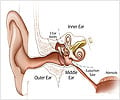Scientists have supported the idea that human speech evolved less from vocalizations than from communicative facial gestures in a new study.

But unlike these primate calls, human speech is produced using rapid, controlled movements of the tongue, lips and jaw. Speech is also learned, while primate vocalizations are mostly innately structured.
Researchers at Princeton and the University of Vienna used x-ray movies to investigate lip-smacking gestures in macaque monkeys. Lip smacks are made by many monkey species in friendly, face-to-face situations (e.g. between mothers and their infants).
Although lip-smacking makes a quiet sound (similar to "p p p p"), it is not accompanied by phonation, which is produced by vocal cord vibration in the "voice box" or larynx.
Although superficially lip-smacking appears to involve simply rapid opening and closing of the lips, the x-ray movies show that lip-smacking is actually a complex behaviour, requiring rapid, coordinated movements of the lips, jaw, tongue and the hyoid bone (which provides the supporting skeleton for the larynx and tongue).
Furthermore these movements occur at a rate of about 5 cycles per second, the same as speech, and are much faster than chewing movements (about 2.5 cycles per second). Thus, although lip smacking superficially resembles "fake chewing", it is in fact very different, and more like speech.
Advertisement
In particular, the alternation between vowel and consonant that generates speech syllables is strikingly similar to the movements underlying lip-smacking.
Advertisement
Similarly, orangutans can learn to whistle: again a sound produced using the lips and tongue, rather than the larynx.
Together, these data from our primate cousins support the idea that the origins of speech might be found in an evolutionary combination of "traditional" phonation (sounds produced by the vocal cords, in the larynx) with rapid, learned movements of the vocal tract, which have stronger similarities to primate facial signals than to their innate calls.
But the origin of the "singing" component of speech, which requires voluntary control over the larynx, remains mysterious.
The study has been published in Current Biology.
Source-ANI










